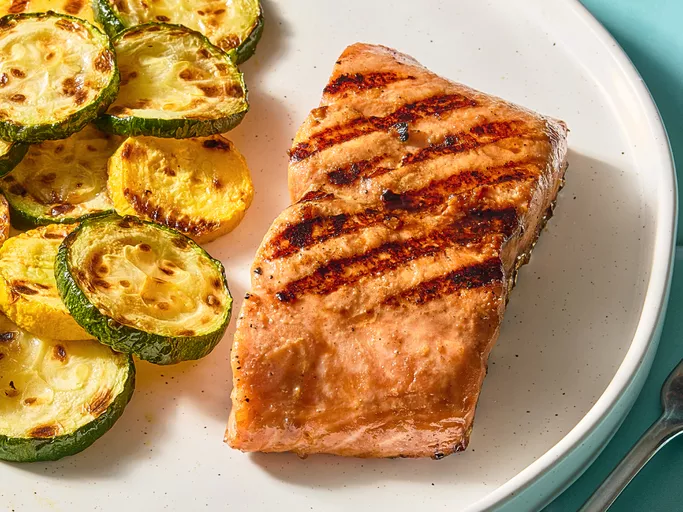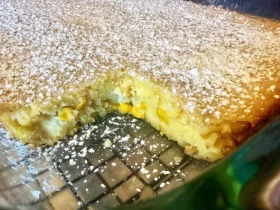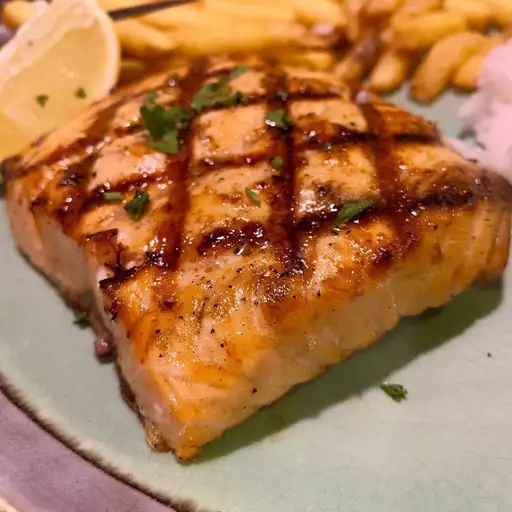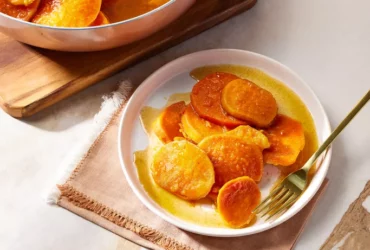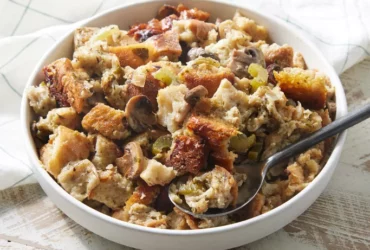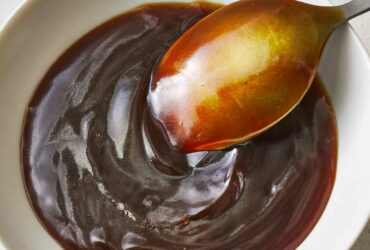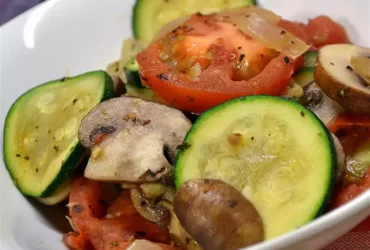Preparation
Selecting Fresh Salmon
To achieve the best results with any recipe that involves grilled salmon, it’s crucial to begin by preparing the fish correctly. Preparation begins with selecting the right type and quality of salmon.
The first step in this process is understanding the various types of salmon available. The two main species are Atlantic and Pacific Salmon, with each having its unique characteristics, taste, and texture. When choosing between them, consider what flavor profile you’re aiming for. If you want a milder taste, opt for Atlantic; otherwise, Pacific Salmon offers a richer flavor.
Next, ensure that the salmon you choose is fresh. Freshness can significantly impact both the taste and safety of your final dish. Look for fish with shiny, metallic scales and bright, clear eyes. Avoid any with dull or sunken eyes since these are indicative of old age. The flesh should be firm to the touch and not easily damaged when pressed.
When purchasing salmon from a store, also consider where it comes from. Salmon farmed in some parts of the world may contain higher levels of pollutants than those caught wild. For example, Alaskan or Icelandic wild-caught salmon tends to have better quality and lower environmental impact compared to farmed fish from other locations.
Another important aspect of preparation is storage. Fresh salmon should be stored on ice as soon as possible after purchase to prevent spoilage. This also helps in preventing the growth of bacteria, ensuring that your salmon stays fresh for a longer period.
Finally, before grilling, make sure you’ve properly cleaned and patted dry the fish. Excess moisture can lead to a less appealing texture when cooked. A good seasoning or marinade can enhance the flavor of the salmon without adding excess moisture, which is another important step in preparing it for the grill.
By following these steps – understanding the different types of salmon, choosing fresh and high-quality fish, considering its origin, storing it correctly, cleaning and drying it before grilling – you’ll be able to enjoy your grilled salmon dish with the best possible flavor and texture.
Look for salmon with a pleasant ocean smell and shiny appearance
- To ensure that you end up with a perfectly cooked grilled salmon dish, it’s essential to start by selecting the right type of salmon.
- The first step in preparing your grilled salmon is to choose fish with a pleasant ocean smell and shiny appearance.
- This involves visiting your local seafood market or grocery store and carefully examining the salmon on display.
- Look for salmon fillets that have a shiny, moist appearance, as this will indicate freshness and quality.
- Avoid choosing salmon with dull, dry, or discolored skin, as these are signs of low quality and poor handling practices.
- In addition to visual inspection, also check the fish for any strong, unpleasant odors.
- Fishy smells can be a sign that the fish has spoiled or is of poor quality, so it’s essential to trust your senses when making this selection.
- When selecting salmon with a pleasant ocean smell and shiny appearance, you should also check the texture of the flesh for firmness and freshness.
- A fresh salmon fillet will feel firm to the touch, whereas an older or lower-quality fish may feel soft or squishy.
- Once you’ve selected your high-quality salmon fillets, it’s essential to prepare them correctly before grilling.
- This includes rinsing the fish under cold water and patting it dry with paper towels to remove excess moisture.
- Remove any scales or fins and make sure the fish is free of any visible bloodlines or defects.
- Now your salmon is ready for the grill, so let’s proceed with our grilled salmon recipe!
Check for any signs of spoilage or damage
The preparation stage of grilling salmon is crucial to ensure that the dish turns out delicious and safe to eat. Here’s a step-by-step guide on how to prepare salmon for grilling.
First, make sure you have fresh salmon fillets with no signs of spoilage or damage. Check the fish for any unusual odors, slimy texture, or mold growth. If you notice any of these symptoms, it’s best to discard the fish and purchase a new one.
Clean and pat dry the salmon fillets with paper towels. Remove any bloodlines or dark spots, as they can make the fish taste bitter.
Rinse the salmon under cold water to remove any impurities. Pat them dry again with paper towels to prevent bacterial growth during cooking.
Season the salmon with your desired herbs and spices. Some popular options for grilled salmon include lemon juice, olive oil, garlic powder, salt, and pepper. You can also add some chopped fresh herbs like parsley or dill for added flavor.
Cover the salmon with plastic wrap or aluminum foil to prevent them from drying out during marination. Place them in the refrigerator for at least 30 minutes to allow the flavors to penetrate.
Preheat your grill to medium-high heat (around 400°F). Make sure the grates are clean and brush them with oil to prevent the salmon from sticking.
Remove the salmon from the marinade, letting any excess liquid drip off. Place the salmon on the grill, skin side down if it has skin. Close the lid to allow the fish to cook evenly.
Grill the salmon for 4-6 minutes per side, or until it reaches your desired level of doneness. For medium-rare, cook for 3-4 minutes per side. Use a meat thermometer to check the internal temperature, which should be around 145°F.
Once cooked, remove the salmon from the grill and place it on a plate. Let it rest for a few minutes before serving to allow the juices to redistribute.
Choose wildcaught Alaskan or Pacific Northwest salmon for the best flavor and nutritional profile (according to the USDA)
To achieve optimal results when making a grilled salmon recipe, it’s essential to start with the freshest and highest-quality ingredients possible.
In this case, we recommend choosing wild-caught Alaskan or Pacific Northwest salmon for its exceptional flavor and nutritional profile, as endorsed by the United States Department of Agriculture (USDA).
The benefits of opting for wild-caught salmon include:
- A more robust flavor profile
- Higher levels of omega-3 fatty acids
- Lower mercury content compared to farmed salmon
The unique characteristics of Alaskan and Pacific Northwest salmon can be attributed to the region’s pristine waters, abundant food supply, and moderate climate. These factors contribute to a higher concentration of nutrients and better overall quality.
To further prepare your salmon for grilling, consider the following steps:
Salmon selection
Opt for fillets that are firm, moist, and have a good balance between fatty and lean areas. You can choose from various types such as King, Sockeye, or Coho.
Rinse and pat dry
Rinse the salmon under cold running water to remove any impurities or excess moisture. Pat it dry with paper towels to prevent steaming instead of searing during grilling.
Seasoning and marinades
Apply your preferred seasonings, herbs, or marinades to enhance the flavor. You can use a mixture of olive oil, lemon juice, garlic, and dill for a classic combination.
Grilling temperature and time
Preheat your grill to medium-high heat (around 400°F). Cook the salmon for 4-6 minutes per side or until it reaches an internal temperature of 145°F. Make sure to not overcrowd the grill, as this can affect cooking times.
By following these guidelines and using wild-caught Alaskan or Pacific Northwest salmon, you’ll be able to create a delicious grilled salmon recipe with exceptional flavor and nutritional value.
Grilling Techniques
Oiling and Seasoning
- The art of grilling a perfect piece of fish, such as salmon, requires a combination of technique and knowledge of grilling fundamentals.
- First and foremost, it’s essential to Oil the grates before adding your food. This is crucial to prevent sticking and ensure easy removal after cooking.
- To oil the grates, simply dip a paper towel in some vegetable oil, such as canola or grapeseed, and rub it evenly over the grates with long strokes.
- This helps to create a non-stick surface and prevents your fish from sticking to the grill.
- Once you’ve oiled the grates, it’s time to focus on Seasoning. Salmon is naturally flavorful, but adding some extra seasoning can elevate its taste to the next level.
- Some popular seasonings for salmon include lemon juice, garlic powder, and paprika.
- You can also try mixing together a combination of herbs, such as dill weed, parsley, and thyme, for added flavor.
- To season your salmon, simply rub it gently with a mixture of oil, lemon juice, and seasoning, making sure to coat it evenly.
- Now that we’ve covered the basics of grilling, let’s talk about some specific techniques you can use to achieve the perfect grilled salmon.
- The most important thing to remember when grilling is to cook over high heat. This will help create a nice sear on the outside of the fish while keeping it juicy and tender on the inside.
- To get started, preheat your grill to high heat (around 450-500°F or 230-260°C).
- Once the grill is hot, place your salmon fillets on the grates, making sure they’re not overcrowded.
- Close the lid and let it cook for about 4-6 minutes, depending on the thickness of the fish.
- You can check to see if it’s done by inserting a fork or knife into the thickest part of the fillet – if it flakes easily, it’s cooked through.
- Remember to keep an eye on the temperature and adjust the cooking time as needed.
- When your salmon is cooked, remove it from the grill and let it rest for a few minutes before serving.
- This will allow the juices to redistribute throughout the fish, making each bite even more delicious.
- And there you have it – a perfectly grilled piece of salmon, infused with the flavors of lemon juice, garlic powder, and herbs. Bon appétit!
Brush both sides of the salmon with a mixture of olive oil, lemon juice, and chopped fresh herbs like parsley or dill
- To achieve perfection when grilling salmon, it’s essential to understand the various techniques involved.
Preparation
- The first step in grilling salmon is to prepare it for cooking.
- Choose fresh and high-quality salmon fillets, making sure they are of a uniform thickness to ensure even cooking.
- Rinse the salmon under cold water, pat it dry with paper towels to remove excess moisture, and season both sides with salt and pepper.
Brushing the Salmon
To add flavor and create a delicious glaze on the surface of the salmon, brush both sides with a mixture of olive oil, lemon juice, and chopped fresh herbs like parsley or dill.
Olive Oil
Use a high-quality extra-virgin olive oil to give the salmon a rich and savory flavor. You can also use avocado oil or grapeseed oil as alternatives.
Lemon Juice
Squeeze fresh lemon juice over the salmon to add a burst of citrus flavor and help preserve the fish’s natural moisture. Be careful not to overdo it, as too much acidity can make the fish taste sour.
Chopped Fresh Herbs
Use fragrant herbs like parsley, dill, or tarragon to add a bright and refreshing flavor to the salmon. Simply chop the herbs finely and sprinkle them over both sides of the fish.
Grilling Techniques
Once you have prepared and brushed your salmon fillets, it’s time to fire up your grill!
Indirect Grilling
Place the salmon on a preheated grill over indirect heat (at least 4-5 inches away from the flames). Close the lid and cook for about 8-10 minutes per side, or until it reaches an internal temperature of 145°F – 150°F.
Medium-High Heat Grilling
If you prefer a more caramelized crust on your salmon, use medium-high heat (around 400°F) for the first 2-3 minutes per side. Then, reduce the heat to low-medium and cook for another 4-6 minutes or until it reaches the desired internal temperature.
Finishing Touches
To add a final touch of flavor and presentation, garnish your grilled salmon with additional fresh herbs, lemon wedges, or microgreens.
Remember to let the salmon rest for about 5-10 minutes after grilling before serving. This allows the juices to redistribute, making each bite even more flavorful and tender!
Sprinkle with salt, pepper, and any other seasonings you like (such as garlic powder or paprika)
To achieve perfect grilled salmon, it’s essential to understand the different grilling techniques that will help bring out the flavors and texture of this delicious fish.
First and foremost, preheat your grill to medium-high heat, around 400°F (200°C). This temperature range will ensure a nice sear on the outside while keeping the inside tender and juicy.
Select a high-quality salmon fillet, preferably fresh and with good fat content. Salmon’s rich flavor pairs well with a variety of herbs and spices, but for this recipe, we’ll focus on classic seasoning.
Take the salmon out of the refrigerator about 30 minutes before grilling to allow it to come to room temperature. This step will prevent the fish from cooking unevenly and promote even grilling.
Rinse the salmon under cold water, pat it dry with a paper towel, and gently place it on a preheated grill grate. Close the lid to trap the heat and smoke, which helps infuse flavors into the fish.
Sprinkle both sides of the salmon with salt, pepper, and any other seasonings you like (such as garlic powder or paprika). Don’t be shy with the seasoning – it will help balance out the richness of the fish. You can also add some lemon juice for an extra burst of citrus flavor.
Grill the salmon for about 4-5 minutes per side, depending on its thickness and your desired level of doneness. You may need to adjust the cooking time based on the heat of your grill and the type of salmon you’re using.
Once cooked through, remove the salmon from the grill and let it rest for a few minutes before slicing and serving. The resting period allows the juices to redistribute within the fish, making each bite more flavorful and satisfying.
Some additional tips to keep in mind: make sure to oil your grates beforehand to prevent sticking, and don’t overcrowd the grill – cook in batches if necessary. This will ensure that each piece of salmon gets an even amount of heat and attention.
With these grilling techniques and a little practice, you’ll be well on your way to creating mouth-watering grilled salmon recipes that impress friends and family alike!
Allow the salmon to sit at room temperature for 30 minutes before grilling
To achieve a perfectly grilled piece of salmon, it’s essential to understand the importance of proper preparation and technique. Before grilling, make sure to allow your salmon to sit at room temperature for 30 minutes. This step may seem trivial, but it’s crucial in ensuring that the fish cooks evenly.
During this time, the salmon will begin to break down its proteins, making it more receptive to the heat of the grill. If you place a cold piece of salmon directly onto the grates, it will likely result in a cooked exterior and an undercooked interior.
Once your salmon has reached room temperature, you can proceed with preheating your grill to medium-high heat. It’s essential to use a thermometer to ensure that the grill is at the correct temperature. For salmon, you want the grill to be around 400°F (200°C) to achieve a nice sear on the outside while cooking the fish through.
Next, season your salmon with your desired spices and herbs. Make sure to rub them gently into the flesh to prevent any loose particles from falling off during grilling. You can use a variety of seasonings such as lemon juice, olive oil, garlic powder, or dill weed to give your salmon a unique flavor.
Once your grill is preheated and your salmon is seasoned, place the fish onto the grates, skin side down (if it has skin). Close the grill lid and allow the salmon to cook for 4-6 minutes or until it reaches an internal temperature of 145°F (63°C). If you’re unsure about the doneness, use a fork to check if the fish flakes easily.
After flipping the salmon over and cooking for an additional 2-3 minutes, remove it from the grill and let it rest for a few minutes. This will allow any juices to redistribute, making your salmon even more tender and flavorful.
Finally, slice your grilled salmon into thin pieces and serve immediately. You can enjoy it as is or with your favorite sides such as steamed vegetables, roasted potatoes, or quinoa salad. The key to a perfectly grilled piece of salmon lies in the attention to detail and the technique used throughout the cooking process.
By following these steps and using a combination of proper preparation and grilling techniques, you’ll be able to achieve a beautifully cooked piece of salmon that’s sure to impress your friends and family. Whether you’re a seasoned chef or a beginner in the kitchen, this grilled salmon recipe is an excellent way to get started on your culinary journey.
Serving Suggestions
Pairing With Sides and Sauces
To enhance the flavors and textures of the grilled salmon recipe, several serving suggestions can be explored.
Serving Suggestions
Grilled Asparagus with Lemon Aioli: Serve the salmon alongside a side of asparagus that has been brushed with olive oil and grilled to perfection. Offer a dollop of lemon aioli on the side for added richness and brightness.
Roasted Vegetable Salad: Combine roasted vegetables such as Brussels sprouts, red bell peppers, and sweet potatoes with mixed greens and a drizzle of balsamic vinaigrette for a light and refreshing accompaniment to the salmon.
Grilled Pineapple Skewers: Alternate chunks of pineapple and onions on skewers and brush with a mixture of brown sugar, soy sauce, and rum for a sweet and savory contrast to the smoky salmon.
Pairing With Sides
Herbed Quinoa: Cook quinoa according to package instructions and mix in chopped fresh herbs such as parsley, dill, or chives for added flavor and nutrition. The light texture of quinoa pairs well with the rich flavors of salmon.
Sautéed Spinach: Quickly sauté a handful of spinach leaves in olive oil until wilted, then season with garlic, lemon juice, and red pepper flakes for added depth of flavor.
Sauces
Lemon-Dill Sauce: Mix together Greek yogurt, freshly chopped dill, lemon zest, lemon juice, salt, and pepper for a light and refreshing sauce to serve over the salmon.
Teriyaki Glaze: Combine soy sauce, brown sugar, rice vinegar, and sesame oil in a small saucepan and simmer until thickened. Brush the glaze over the salmon during the last few minutes of grilling for a sweet and sticky coating.
Grill asparagus or bell peppers alongside the salmon for a tasty and healthy side dish
To elevate the flavor and presentation of your grilled salmon, consider serving it with a variety of delicious sides that complement its rich flavors.
Here are some serving suggestions that pair perfectly with this dish
Grill asparagus or bell peppers alongside the salmon for a tasty and healthy side dish. The smoky flavor from grilling will add a nice depth to these vegetables, making them a great accompaniment to your salmon.
Roasted sweet potato wedges make a satisfying side that pairs well with the savory flavors of salmon. Simply toss the sweet potato wedges with olive oil, salt, and pepper, and roast them in the oven until crispy.
A refreshing salad with mixed greens, cherry tomatoes, cucumber, and citrus vinaigrette provides a nice contrast to the richness of the salmon. You can also add some protein-rich ingredients like grilled chicken or edamame to make it more substantial.
Quinoa or brown rice pilaf is another great option to serve with your grilled salmon. Cook these whole grains according to package instructions and toss them with chopped herbs, lemon juice, and olive oil for added flavor.
In addition to these side dishes, you can also consider serving your grilled salmon with a variety of sauces or marinades that add extra flavor and moisture. Some popular options include:
- Lemon-dill sauce: Mix together freshly squeezed lemon juice, chopped fresh dill, garlic, and olive oil for a bright and refreshing sauce.
- Asian-style glaze: Combine soy sauce, honey, ginger, and garlic to create a sweet and savory glaze that adds depth to the salmon.
These are just a few ideas to get you started. Feel free to experiment with different ingredients and flavor combinations to find your perfect match!
Serve with a drizzle of tartar sauce or a squeeze of fresh lemon juice for added flavor
To elevate your Grilled Salmon experience, consider serving it with a variety of accompaniments that will complement its delicate flavors.
One classic option is to serve with a drizzle of tartar sauce, which adds a tangy and creamy element to the dish. The acidity in the tartar sauce helps to cut through the richness of the salmon, creating a lovely balance of flavors on the palate.
Alternatively, a squeeze of fresh lemon juice can be just as effective in adding brightness and citrus notes to the dish. Simply slice the lemon into wedges or juice it directly over the salmon for an added burst of flavor.
If you want to get creative with your serving suggestions, consider pairing the grilled salmon with some toasted baguette slices or crusty bread, which can be used to mop up any remaining sauce or juices from the plate. You could also serve the salmon with a side of roasted vegetables, such as asparagus or Brussels sprouts, which will add a pop of color and texture to the dish.
Another idea is to serve the grilled salmon with a simple green salad, featuring mixed greens and some lighter vinaigrette options. This will help to cut through the richness of the salmon and provide a refreshing contrast in textures.
In terms of other serving suggestions, you could also consider serving the grilled salmon with some warm quinoa or brown rice, which can be flavored with herbs like thyme or rosemary for added depth. Alternatively, try serving the salmon with some sautéed spinach or garlic scapes for a more decadent and indulgent twist.
The key to creating an impressive serving experience is to consider the flavors and textures of each component and balance them harmoniously on the plate. Whether you’re in the mood for something light and fresh or rich and indulgent, there’s a serving suggestion that will elevate your Grilled Salmon Recipe to new heights!
Pair with quinoa, brown rice, or roasted vegetables for a wellrounded meal (suggested by the American Heart Association)
Serving suggestions play a significant role in elevating the overall dining experience, especially when paired with a delicious grilled salmon recipe. The versatility of this dish allows for various accompaniments that not only complement its flavors but also provide a well-rounded and nutritious meal.
One such suggestion is to pair the grilled salmon with quinoa or brown rice, as recommended by the American Heart Association. Both of these options offer an excellent source of complex carbohydrates, fiber, and protein, making for a satisfying and balanced meal.
The addition of roasted vegetables adds not only visual appeal but also a burst of flavors and textures to each bite. Roasting brings out the natural sweetness in vegetables like asparagus, Brussels sprouts, or carrots, which pairs beautifully with the smokiness from grilling the salmon.
Another serving suggestion is to serve the grilled salmon with a side salad, composed of mixed greens, cherry tomatoes, cucumber, and red onion. The tangy dressing adds a refreshing contrast to the rich flavors of the salmon, creating a delightful harmony on the palate.
To add some excitement to this meal, consider pairing the grilled salmon with some flavorful sides like sautéed spinach with garlic and lemon or roasted sweet potato wedges seasoned with herbs and spices. These options will not only tantalize your taste buds but also provide essential nutrients for a healthy meal.
Incorporating these serving suggestions into your grilled salmon recipe allows you to create a truly memorable dining experience that not only delights the senses but also promotes overall well-being. So, go ahead and get creative with your pairings and elevate this dish to new heights!
- Best Clay Alternatives for 2025 - April 22, 2025
- Best Leadfeeder Alternatives for 2025 - April 22, 2025
- Best Snov.io Alternatives for 2025 - April 21, 2025

